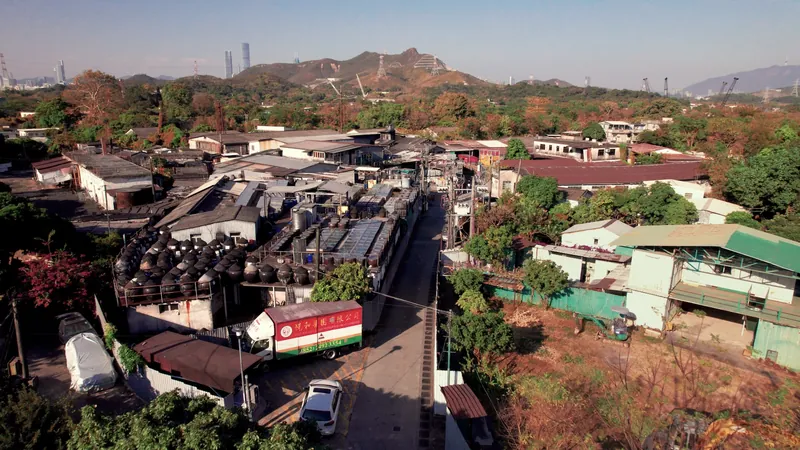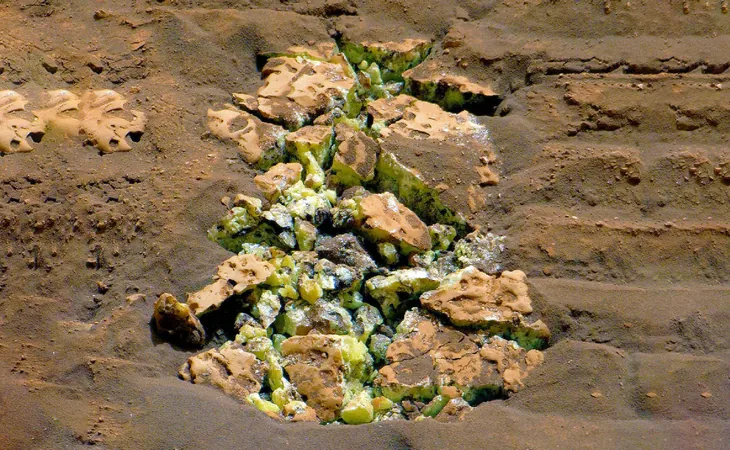
The Northern Metropolis: A Bold Vision or a Threat to Hong Kong's Heritage?
2025-03-25
Author: Wei
Introduction
As Hong Kong embarks on the monumental task of creating a sprawling 30,000-hectare housing and technology hub known as the Northern Metropolis, questions arise about its implications for both the local population and the environment.
Voices of Concern
“I don’t know where I am going to go. We will see, I guess,” laments Wong Hung-kuen, the last owner of a large sawmill in Hong Kong. Now in his seventies, Wong sits among heaps of discarded streetlight poles he has repurposed into furniture, reflecting the long-standing tradition of craftsmanship passed down through generations. “Also, who will take care of these dogs?” he asks, gently stroking a stray he feeds.
His neighbor, Jack Pong, is a third-generation soy sauce manufacturer who faces similar worries. Standing amidst the rooftop vats that must soak in the sun, he expresses frustration: “It is not easy to find a place for a soy sauce factory in Hong Kong these days.” Both Wong and Pong reside in Kwu Tung, an area that has undergone significant redevelopment since 2023 and is now poised to be swallowed by urbanization.
The Northern Metropolis Concept
Dubbed a “technology hub,” the Northern Metropolis will incorporate existing regions such as Tin Shui Wai, Yuen Long, and Fanling/Sheung Shui, alongside vast tracts of rural land, which includes the settlements at Kwu Tung North, Hung Shui Kiu, and more. This ambitious reconstruction is not merely an urban upgrade; it is part of a larger strategy to knit Hong Kong into the Guangdong–Hong Kong–Macao Greater Bay Area, effectively erasing borders in favor of a sprawling megacity.
Cultural and Environmental Implications
Kwu Tung, currently charmingly rural with its small community of artisans, organic farms, and traditional eateries, serves as a vivid reminder of life before the machinery of modernization rolls in. Historic sites like an old brick schoolhouse and former wet market are juxtaposed with the shadows of forthcoming skyscrapers, their foundations being laid as cranes loom overhead.
While development promises economic growth, it carries a steep ecological price. The transformation threatens the nearby Mai Po Nature Reserve, a haven for rare wildlife, as increased construction and traffic will disrupt their natural habitats. The local population, comprised largely of farmers and artisans who lack representation in governmental decision-making, finds their futures uncertain as plans progress, often without their input.
Artistic Documentation of Lives
In an effort to document the experiences of Kwu Tung residents, local artist Daphnė Mandel and photographer Guy Bertrand created the documentary *Cha Guo (2024)*. The film offers a poignant look into lives shaped by tradition—like that of Sam Lui, who not only creates soy sauce but also embodies a cooking persona named Wendy as part of a creative arts project. However, the documentary glides over the harsh realities that many of its subjects face, particularly the necessity to relocate as construction advances.
The Shadow of the National Security Law
Since the implementation of the National Security Law in 2020, open discourse around such pressing issues has dramatically shifted. Conversations about relocation and the loss of cultural identity are now often conducted with caution, suggesting a collective understanding that discussing government policies may invite scrutiny or reprisal.
Shared Narratives of Displacement
Both Wong and Pong convey a shared narrative of displacement—of Hongkongers gradually being exiled to the outskirts as the city develops. Wong's sawmill, which first opened in the central district of Wan Chai in the early 1940s, has moved numerous times due to encroaching urban projects. Similarly, Pong’s soy sauce factory faced continuous relocations, each time forced to adapt to fewer spaces as development agendas unfolded without community consultation.
Conclusion—A Crossroad for Hong Kong's Identity
As the Northern Metropolis rises, the tensions between progress and preservation intensify. Will this project bring prosperity or dismantle the very essence of what makes Hong Kong unique? The answer remains clouded in uncertainty, as local residents grapple with a future that feels increasingly out of their hands. As we stand at this crossroad of development, it’s critical to voice the stories that risk being overlooked in the fray. This is not merely a construction project; it is a defining moment for Hong Kong's identity and cultural legacy. The discussion is far from over, yet the implications of its silence are deafening.



 Brasil (PT)
Brasil (PT)
 Canada (EN)
Canada (EN)
 Chile (ES)
Chile (ES)
 Česko (CS)
Česko (CS)
 대한민국 (KO)
대한민국 (KO)
 España (ES)
España (ES)
 France (FR)
France (FR)
 Hong Kong (EN)
Hong Kong (EN)
 Italia (IT)
Italia (IT)
 日本 (JA)
日本 (JA)
 Magyarország (HU)
Magyarország (HU)
 Norge (NO)
Norge (NO)
 Polska (PL)
Polska (PL)
 Schweiz (DE)
Schweiz (DE)
 Singapore (EN)
Singapore (EN)
 Sverige (SV)
Sverige (SV)
 Suomi (FI)
Suomi (FI)
 Türkiye (TR)
Türkiye (TR)
 الإمارات العربية المتحدة (AR)
الإمارات العربية المتحدة (AR)